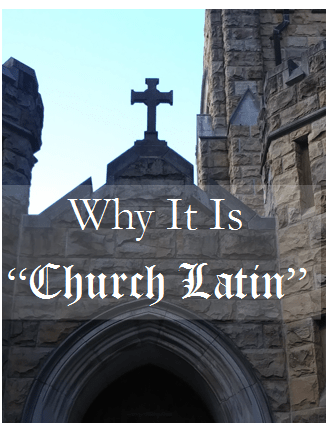
“Church Latin” is the informal, snappier-sounding term for the more scholarly phrase Ecclesiastical Latin, or the occasionally-used Medieval Latin. All of these terms are used to denote something different from “Classical Latin”–the Latin used by, say, Julius Caesar. Church Latin was (and is!) the Latin used by the Catholic Church for two thousand years–thus, where the “Church” part comes in.
But wait–isn’t it exactly the same language we’re talking about here? Same words and grammar and endings all? Well yes…and no. Differences can be summarized in six interrelated points.
- Pronunciation. As Latin aged and spread throughout Europe, its syllables were eventually pronounced differently than they had been during the Classical era. Happily it’s much easier to learn Ecclesiastical pronunciation than Classical, as the rules are simpler. Here is a guide.
- Words. Of all the important reasons for thinking of Church Latin as its own thing, its distinctive vocabulary is the most important reason. It has been considered a dialect of Latin specific to Christians. Because the subject matter (see below) of writers after Classical Roman times was so specific to Christian thought, hundreds of new Latin words had to be forged. New words were created through adaptations of Greek and Hebrew terms to express theological ideas. Furthermore, new meanings were created for old Latin words already used, so, depending on the author and his era, the “same” Latin word can really be two different terms. This is why there are Latin dictionaries and then Ecclesiastical Latin dictionaries (and Latin students should have both!).
- Subject matter. As we’ve seen above, the reason the vocabulary of Church Latin is so different from that of Classical Latin is because the content of the writings of the post-Classical era (Middle Ages and after) is so very different from what they were writing in the days of gladiators and public baths. Sts. Augustine and Thomas Aquinas discussed things that were on an entirely different plane of existence than those found in the works of Terence and Tacitus. Church Latin is the Latin of the Mass and Divine Office, of Catholic theology, Canon Law, the Vulgate Scriptures, Gregorian Chant…all of these things required hundreds ideas and terms the ancient Romans never used or even thought of.
- Time Period. The closing of the period for Classical Latin is over even before the end of the Empire, about the 300s AD. Ecclesiastical Latin as we know it then dates from about 300–going forward technically until the present, but seeing its heyday in Europe ending after the 1600s and losing its remaining wide Catholic usage in the 1900s. (But–it shall rise again!)
- Style. The Christian writers over the centuries developed and favored certain styles and conventions in their Latin compositions that were not really used in Classical Latin texts. As an example, a rhythmical arrangement of syllables called the cursus was used over and over again in liturgical prayers by writers in Ecclesiastical Latin. Classical Roman poetry and prose had different conventions and favorite arrangements.
- Role. After the decayed Roman Empire fell under the final waves of barbarian onslaughts in the 400s, Latin ceased to be the language of people’s daily life. However, at the same time as it was lost in the day-to-day affairs of all the common people, because of its place in religion, Latin was still commonly and universally used in worship and study everywhere, every day. This resulted in Latin becoming a specialized language, used above and alongside the developing vernaculars of the soon-to-be-medieval European countries. As a language set apart, yet a commonly known language used throughout the whole of Europe, north, south, east, and west, Church Latin was Latin reserved for sacred and scholarly uses.
So–Latin is Latin, until the point when you are deciding what you want to read. If you want to read the writings of Europeans after the 300s AD, you’re going to want to learn the vocabulary and conventions of Ecclesiastical Latin. Church Latin is Classical Latin’s pious and thoughtful little brother–they’re from the same family, but they have different personalities and totally different interests!
Hey, just wanted to say that I just discovered this site. Please continue with your hard work. I have forwarded the link to my online catholic school (Ascend Online). Who knows, this may become a valuable resource for our students.
God Bless
LikeLike
Thank you! God bless you! AMDG!
LikeLiked by 1 person
Thank you for all your hard work! You are a great resource!
LikeLike
Thank you for stopping by, and I’m so glad to be able to help! Best of luck with your studies!
LikeLike
Hi, I just came across your website and I love it! Please continue it, I will include a link to your website on my website later.
LikeLike
Thank you very much for stopping by the site, and I appreciate your kindness. Thanks and may God bless you!
LikeLike
The clearest explanation yet of the difference between the two Latins. Thanks and best wishes. Mike.
LikeLike
Thank you so much for stopping by! It’s so good to hear from readers–God bless you!
LikeLike
This is definitely the best explanation I’ve ever read about the difference between Classical and Ecclesiastical Latin. As a Sacred Music director for a Latin Mass parish, I’m very interested in taking your courses and recommending them to my schola. Please email me more information!
LikeLike
Thanks so much! I am so glad you found this useful. I love working with singers–Sacred Music is how I discovered Catholic Tradition! I will e-mail you soon. Again, thanks and God bless you!
LikeLike